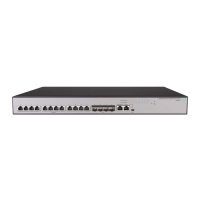138
Related commands
dns proxy enable
ipv6 host
Use ipv6 host to create a host name-to-IPv6 address mapping.
Use undo ipv6 host to remove a host name-to-IPv6 address mapping.
Syntax
ipv6 host host-name ipv6-address [ vpn-instance vpn-instance-name ]
undo ipv6 host host-name ipv6-address [ vpn-instance vpn-instance-name ]
Default
No host name-to-IPv6 address mappings exist.
Views
System view
Predefined user roles
network-admin
Parameters
host-name: Specifies a host name, a case-insensitive string of 1 to 253 characters. It can include
letters, digits, hyphens (-), underscores (_), and dots (.).
ipv6-address: Specifies the IPv6 address of the host.
vpn-instance vpn-instance-name: Specifies an MPLS L3VPN instance by its name, a
case-sensitive string of 1 to 31 characters. To create a host name-to-IPv6 address mapping for the
public network, do not specify this option.
Usage guidelines
The system allows a maximum of 1024 host name-to-IPv6 address mappings for the public network
or each VPN instance. You can configure host name-to-IPv6 address mappings for both public
network and VPN instances.
For the public network or a VPN instance, each host name maps to only one IPv6 address. If you
execute this command multiple times, the most recent configuration takes effect.
Do not use the ping ipv6 command parameter -a, -c, -i, -m, -q, -s, -t, -tc, -v, or -vpn-instance as the
host name. For more information about the ping ipv6 command parameters, see Network
Management and Monitoring Command Reference.
Examples
# Map IPv6 address 2001::1 to host name aaa for the public network.
<Sysname> system-view
[Sysname] ipv6 host aaa 2001::1
Related commands
ip host
reset dns host
Use reset dns host to clear dynamic DNS entries.

